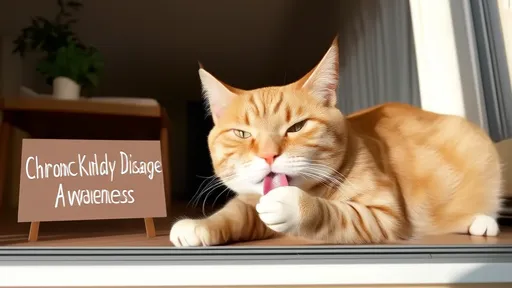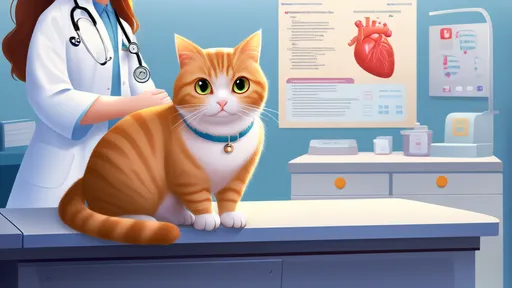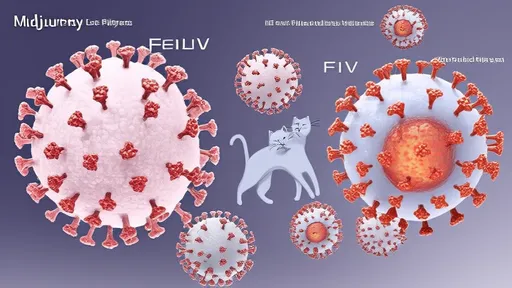Feline leukemia virus (FeLV) and feline immunodeficiency virus (FIV) are two of the most significant viral infections affecting cats worldwide. Often referred to as "feline AIDS" and "feline leukemia," these diseases can have devastating effects on a cat's health. While both viruses weaken the immune system, they differ in transmission, progression, and long-term outcomes. Understanding these differences is crucial for cat owners to provide the best care for their pets.
Feline leukemia virus is a retrovirus that compromises a cat's immune system, making them susceptible to secondary infections and certain types of cancer. FeLV is highly contagious and spreads through close contact, such as mutual grooming, shared food bowls, or bite wounds. Kittens can also contract the virus from their mothers during pregnancy or through nursing. Unlike FIV, FeLV can survive outside the body for a short period, increasing the risk of environmental transmission. Cats living in multi-cat households or those that roam outdoors are at higher risk.
Feline immunodeficiency virus, on the other hand, is more similar to human HIV. It attacks the immune system gradually, often leading to a prolonged asymptomatic phase before progressing to full-blown immunodeficiency. FIV is primarily transmitted through deep bite wounds, making it more common among unneutered male cats that fight for territory. Casual contact, such as sharing food bowls or litter boxes, poses minimal risk. This distinction in transmission routes is critical for managing multi-cat environments and preventing outbreaks.
The clinical signs of FeLV and FIV can overlap, making diagnosis challenging without proper testing. FeLV often presents with recurrent infections, weight loss, anemia, and lymphoma. Some cats may become persistently infected, while others manage to clear the virus. FIV tends to progress more slowly, with initial symptoms like fever and swollen lymph nodes giving way to chronic infections and dental disease as the immune system weakens. Both viruses can lead to a condition similar to AIDS in humans, where opportunistic infections become life-threatening.
Diagnosis typically involves blood tests that detect viral proteins or antibodies. For FeLV, the ELISA test is commonly used in clinics, while PCR tests provide more definitive results. FIV testing usually looks for antibodies, but false positives can occur in vaccinated cats or kittens with maternal antibodies. Veterinarians often recommend retesting after exposure or vaccination to confirm results. Early detection is vital for managing these diseases and preventing spread to other cats.
Treatment options for FeLV and FIV focus on supportive care rather than cure. Antiviral medications like interferon may help some cats, but managing secondary infections and maintaining quality of life are primary goals. Nutritional support, stress reduction, and regular veterinary check-ups can extend a cat's lifespan significantly. Vaccination plays a different role for each virus - FeLV vaccines are widely recommended for at-risk cats, while FIV vaccines are less common due to limited efficacy and interference with testing.
Prevention strategies differ between these viruses. For FeLV, keeping cats indoors, testing new additions to the household, and vaccinating susceptible individuals form the cornerstone of prevention. With FIV, preventing fights through neutering and keeping cats indoors is most effective. Interestingly, co-infection with both viruses can occur, leading to more severe disease progression. This underscores the importance of comprehensive testing and preventive measures for cats with unknown histories.
The prognosis for infected cats varies widely. Some FeLV-positive cats may live normal lifespans with proper care, while others succumb to complications within a few years. FIV-positive cats often enjoy many years of good health before showing symptoms. The key to longevity lies in early detection, excellent husbandry, and prompt treatment of any emerging health issues. Regular monitoring for weight loss, appetite changes, or unusual behavior helps catch problems early.
Research continues to improve our understanding of these feline retroviruses. New diagnostic methods, treatment protocols, and vaccine development offer hope for better outcomes. For now, education remains the most powerful tool in combating these diseases. Cat owners who understand transmission risks, clinical signs, and management strategies can make informed decisions that protect both individual cats and the broader feline population.
Living with an FeLV or FIV-positive cat requires adjustments but can be deeply rewarding. These cats often form strong bonds with their caregivers and can enjoy good quality of life with proper management. The emotional aspect of caring for a cat with a chronic viral infection shouldn't be underestimated - many owners find the experience strengthens their relationship with their pet despite the challenges.
Ultimately, while "feline AIDS" and "feline leukemia" sound frightening, they don't have to be death sentences. With modern veterinary care and dedicated owners, many infected cats live happy, fulfilling lives. The key lies in understanding the diseases, implementing preventive measures, and providing compassionate care tailored to each cat's needs.

By /Jun 28, 2025

By /Jun 28, 2025

By /Jun 28, 2025

By /Jun 28, 2025

By /Jun 12, 2025

By /Jun 12, 2025

By /Jun 12, 2025

By /Jun 12, 2025

By /Jun 12, 2025

By /Jun 12, 2025

By /Jun 12, 2025

By /Jun 12, 2025

By /Jun 12, 2025

By /Jun 12, 2025

By /Jun 12, 2025

By /Jun 12, 2025

By /Jun 12, 2025